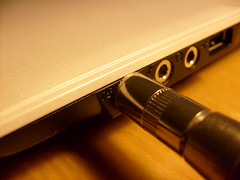Sager NP7680 Unboxing: Explicit SPDIF Support!
 In a previous un-boxing entry, “Sager NP7680 Unboxing: Special Keys and the Fingerprint Reader,” I introduced the special audio control keys for the Sager NP7680. But that audio stuff is trivial (even for nerds) compared to the implications in this image. That first little hole you see there (reading left to right) is a S/PDIF connector. Look at most of the traditional “American” portable computer offerings out there (and I daresay check what’s coming out of Japan too), I am flippantly certain that you will not see such a connector built into these “mainstream” machines—especially for the sub-$1000 range (maybe the Macintosh portables have something).
In a previous un-boxing entry, “Sager NP7680 Unboxing: Special Keys and the Fingerprint Reader,” I introduced the special audio control keys for the Sager NP7680. But that audio stuff is trivial (even for nerds) compared to the implications in this image. That first little hole you see there (reading left to right) is a S/PDIF connector. Look at most of the traditional “American” portable computer offerings out there (and I daresay check what’s coming out of Japan too), I am flippantly certain that you will not see such a connector built into these “mainstream” machines—especially for the sub-$1000 range (maybe the Macintosh portables have something).
 The typical, American business excuse for this lack would be that “the average consumer” does not even know what S/PDIF is—and the conspiracy theorists would say that the RIAA “encourages” American computer manufacturers to heroically spend a few cents less per unit and not put these jacks in… I am sure the folks over at Dell would get close to both of my accusations here. My years of using Dell products deprived me of explicit S/PDIF support for so long that, when I see it here on a Sager, I am truly grateful!
The typical, American business excuse for this lack would be that “the average consumer” does not even know what S/PDIF is—and the conspiracy theorists would say that the RIAA “encourages” American computer manufacturers to heroically spend a few cents less per unit and not put these jacks in… I am sure the folks over at Dell would get close to both of my accusations here. My years of using Dell products deprived me of explicit S/PDIF support for so long that, when I see it here on a Sager, I am truly grateful!
So, my S/PDIF celebration was interrupted a bit when it became clear to me that the RCA-connectors on my cable were not going to fit the 1/8" mini plug coming from Sager. I was searching frantically all over the web and locked on the “Heuson SPDIF cable.” However, the awesome Carl Franklin—soon after my .NET Rocks interview—saved me a few bucks with a solution you can see in this image. Carl made it plain: since S/PDIF is digital this implies that (in analog terms) it’s in mono. It follows that my mono 1/8" adapters work like a charm. Some guy named Andrew Kilpatrick chimes in:
The coax interface uses 75ohm coax cable with RCA connectors. Even cheesy audio patch cables work well for transmitting S/PDIF. The signal is +/-0.5V and should be terminated with 75 ohms on the receiving end. (termination is built into coax inputs)…
The use of the phrase “cheesy audio patch cables” is comforting to me because I tended to assume that S/PDIF connections are more ‘delicate’ than analog ones. So it seemed strange to me that some old-ass mono adapters from Radio Shack (bought way back in the last century) would work so well! You can see the pristine peaks coming into my ancient Windows 98 E-MU APS Black Audio workstation.
This “cheesy” experience also helped me to overcome another incorrect assumption that optical S/PDIF connections are simply superior to metal ones… Here’s a helpful bit from Answers.com:
Note that there are no differences in the signals transmitted over optical or coaxial S/PDIF connectors—both carry exactly the same information. Selection of one over the other rests mainly on the availability of appropriate connectors on the chosen equipment and the preference and convenience of the user.
